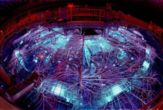Zero to 76,000 mph in a Second

Scientists at the Sandia National Labs in Albuquerque, New Mexico have accelerated a small plate from zero to 76,000 mph in less than a second. The speed of the thrust was a new record for Sandia's "Z Machine" - not only the fastest gun in the West, but in the world too.
The Z Machine is now able to propel small plates at 34 kilometers a second, faster than the 30 kilometers per second that Earth travels through space in its orbit about the Sun. That's 50 times faster than a rifle bullet, and three times the velocity needed to escape Earth's gravitational field.
The ultra-tiny aluminum plates, just 850 microns thick, are accelerated at 1010 g. One g is the force of Earth's gravity. Doing so without vaporizing the plates was possible because of the finer control now achievable of the magnetic field pulse that drives the flight.
Z's hurled plates strike a target after traveling only five millimeters, or less than a quarter-inch. The impact generates a shock wave -- in some cases, reaching 15 million times atmospheric pressure -- that passes through the target material. The waves are so powerful that they turn solids into liquids, liquids into gases, and gases into plasmas in the same way that heat melts ice to water or boils water into steam.
One purpose of these very rapid flights is to help understand the extreme conditions found within the interiors of giant planets in our solar system. By creating states of matter extremely difficult to achieve on Earth, the flyer plates provide hard data to astrophysicists speculating on the structure and even the formation of planets like Jupiter and Saturn.
Didier Saumon, an astrophysicist at Los Alamos National Laboratory, noted that the internal structures of Jupiter and Saturn are composed mostly of hydrogen. So knowing its equation of state -- how hydrogen and its isotopes behave at pressures from one to 50 million atmospheres -- is highly relevant to how scientists infer the interior properties of these planets.
An upgrade of the Z Machine is planned for next year and is expected to achieve higher plate velocities.
Get the world’s most fascinating discoveries delivered straight to your inbox.
Related Stories
- More about the Z Machine
- The World's Smallest Motor
- World's Fastest Plant
- World's Fastest Elevator

Leonard David is an award-winning space journalist who has been reporting on space activities for more than 50 years.


